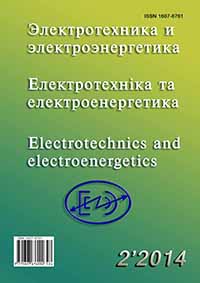ONLINE MONITORING OF THE INSULATION WATER CONTENT CHARACTERISTICS OF THE OILFILLED ELECTRICAL EQUIPMENT
DOI:
https://doi.org/10.15588/1607-6761-2014-2-5Keywords:
monitoring, transformer oil, moisture content, saturation, diagnosisAbstract
The analysis of features of moisture content characteristics monitoring in oil insulation of high voltage electrical equipment under operating voltage is presented. The principles of the water in insulating oil appearance are considered.In the article conclusions are made that for continuous online monitoring of the moisture content of oil transformer there are the most suitable sensors, which measure the relative saturation and the oil temperature at the point of sensor installation, without any additional conversions, and the sensor probe should be directly immersed in the tank of equipment.
The most suitable place for the sensor on the tank, in order to get the closest results to the laboratory ones of the absolute moisture content, is the area of the oil upper layers, provided that the closest results to the actual absolute moisture content value is calculated due to the higher temperature of the oil. But it should be kept in mind that the largest concentration of moisture is at the coldest spots of insulation, respectively, to control the emulsion formation (which is a major challenge in online monitoring) sensor should be placed at the bottom of the tank.
The new method of water content calculation based on relative oil saturation measurement is proposed, new method doesn’t depend from laboratory tests of limit oil saturation. The analysis of the practical monitoring data is made. Recommendations on the organization of the continuous monitoring of the water content and the interpretation of its results are performed
References
Старение изоляции трансформатора [Электронный ресурс] – 2014.– Режим доступа : http://leg.co.ua/transformatory/praktik a/star enie-izolyaciitransformatora.html.
Старение масла в процессе эксплуатации – Регенерация трансформаторных масел [Электронный ресурс] – 2014.– Режим доступа : http://forca.ru/knigi/arhivy/regeneraciya-transformatornyh-masel-4.html.
Непрерывный контроль влагосодержания: (официальный сайт ООО «Энергоавтоматизация») [Электронный ресурс] – 2014 Режим доступа – http://www.enera.com.ua/.
Системы мониторинга высоковольтного оборудования SAFE-T: (официальный сайт ООО «Энергоавтоматизация») [Электронный ресурс]. – 2014. Режим доступа – http://www.enera.com.ua/.
Осотов В.Н. Ошибки при измерении диэлектрических характеристик и оценке состояния высоковольтных вводов: Материалы 10-ой ежегодной конференции «Методы и средства контроля изоляции высоковольтного оборудования» – [Электронный ресурс] – 80 Min / 700 MB. – Пермь : ООО «Димрус», 2013. – 1 електрон. опт.диск (CD-ROM) ; 12 см. – Систем. вимоги: Pentium ; 32 Mb RAM ; Windows 95, 98, 2000, XP ; AdobeAcrobatReader 5.0.
Масла нефтяные. Метод определения растворенной воды : ГОСТ 7822-75. – [Действующий 1977-01-01]. М. : Издательство стандартов, 1984. – 6 с. – (Межгосударственный стандарт).
Жидкости и газы, не взаимодействующие с реактивом Фишера. Кулонометрический метод определения воды : ГОСТ 24614-81. – [Действующий 1982-01-01]. М. :Издательство стандартов. – 2004. – 11 с. – (Межгосударственный стандарт).
Методические указания по определению содержания вода и воздуха в трансформаторном масле: РД 34.43.107-95 / В. В. Бузаев, Б. В. Ванин, Ю. Н. Львов, Н. Ю. Смоленская, Ю. М. Сапожников, Т. В. Глазунова, Р. А. Липштейн, Д. В.Шуварин // Утверждено: Департамент науки и техники РАО «ЕЭС России» 26.12.95. – РАО «ЕЭС России», 1995. – 16 с.
Аракелян В.Г. Диагностика состояния изоляции маслонаполненного электрооборудования по влагосодержанию масла [Электронный ресурс] / Аракелян В.Г. // Электротехника. – 2004. – № 3. – С. 21. – Режим доступа к журналу : http://www.transform.ru/sst/$articles/a000065.htm.
Эффективность методов определения влагосодержания масла силовых трансформаторов [Электронный ресурс] / [В. Соколов, М. Каннингем, Д. Скелли и др.] // СИГРЭ. – 2007. – С. 12. – Режим доступа: http://www.ztz-service.com.ua/Sokolov/
Руководство по эксплуатации CALISTO 2 [Электронный ресурс]. – 2014 / MorganSchafferInc. Режим доступа: http://www.enera.com.ua/products/MSprod/Calisto/Docs.html.
Норми випробування електрообладнання : СОУ-Н ЕЕ 20.302:2007 – Офіц. вид., приказ Мінпаливенерго 2007-01-15 г. №13. – К. : ОЕП «ГРИФРЕ» : М-вопалива та енергетики України, 2007. – 262 с. – (Нормативний документ Мінпаливенерго України).
Moisture solubility for differently conditioned transformer oils / [Y. Du, A. V. Mamishev, B.C. Lesieutre and other] // IEEE Transactions on Dielectrics and Electrical Insulation. – 2001. – Vol. 8, No. 5. – P. 805 –811.
Experimental evaluation of water content determination in transformer oil by moisture sensor: IEEE International Conference on Dielectric Liquids [Электронный ресурс] / [T.Gradnik, M. Koncan-Gradnik, N. Petric, N. Muc] // IEEE. – 2011. – P. 4. –Режим доступа: http://ieeexplore.ieee.org/xpl/login.jsp?tp=&arnumber=6015440&url=http%3A%2F%2nFieeexplore.ieee.org% 2Fxpls%2Fabs_all.jsp%3Farnumber%3D6015440.
Downloads
How to Cite
Issue
Section
License
Copyright (c) 2017 P. D. Andrienko, A. A. Sakhno, S. P. Konogray, L. S. Skrupskaya

This work is licensed under a Creative Commons Attribution 4.0 International License.
Creative Commons Licensing Notifications in the Copyright Notices
Authors who publish with this journal agree to the following terms:
Authors retain copyright and grant the journal right of first publication with the work simultaneously licensed under aCreative Commons Attribution License that allows others to share the work with an acknowledgement of the work's authorship and initial publication in this journal.
Authors are able to enter into separate, additional contractual arrangements for the non-exclusive distribution of the journal's published version of the work (e.g., post it to an institutional repository or publish it in a book), with an acknowledgement of its initial publication in this journal.
Authors are permitted and encouraged to post their work online (e.g., in institutional repositories or on their website) prior to and during the submission process, as it can lead to productive exchanges, as well as earlier and greater citation of published work.

